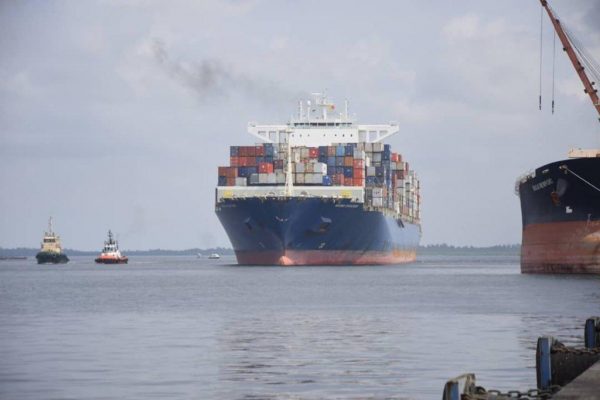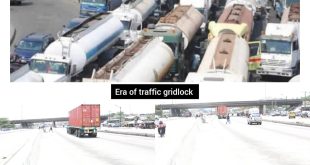
By Kenneth Jukpor
Following the recent arrival of Maersk Stadelhorn vessel, the biggest to ever call at Nigerian ports taking place at West Africa Container Terminal (WACT) in Onne, one of the nation’s Eastern ports facing numerous challenges; the need to reappraise Eastern ports viability, the markets, potentials and challenges has come to the fore.
Although the emergence of the vessel has been attributed to the maintenance dredging at Onne, other factors including high tides, natural harbours have been tipped as responsible for the vessel with the length of 300metres and beam of 48.2metres, capacity to carry about 10,000 TEU (Twenty-foot Equivalent Units).

Irrespective of the reasons for which led to the achievement, the development shows that there are still opportunities for Eastern ports to frequently receive such vessels. Perhaps the arrival of Maersk Stadelhorn was a trial voyage as postulated by Engr. Adams Jatto, General Manager, Corporate Communications and Strategy at Nigerian Ports Authority (NPA) last week, then its success should be replicated with the same circumstances recreated at the other ports in the Eastern region.
Does this mean that sufficient utilization of the already existing ports would dissipate the need for deep seaports in the region? What level of viability, patronage and vessels could Warri, Calabar and Port Harcourt ports attain if maintained at 9-10meters draft? With Onne port’s natural draft of 11.5meters, how effective would the port be if maintained at 13-14meters? Where does that leave the Ibom deep seaport project which has a natural draft of 14.5meters? If Onne port could achieve this feat, could the trick be replicated in Calabar, Warri and Port Harcourt ports?

NPA, earlier this year claimed that the Eastern ports have been receiving flat bottom vessels with large carrying capacity in recent times. How many of such vessels regularly called at these ports? What carrying capacity did such flat-bottom vessels have? Did they require transshipment and who bore the extra cost?

How have the businesses of terminals in the region been affected by draft limitations, having built their projections on a deeper draft proposed by NPA? Should the operators be compelled to pay royalties they entered into on the basis of projected draft and vessel traffic that remains unattainable?
In a bid to proffer answers to these questions, our correspondent consulted several port stakeholders in the Eastern port environment.
Speaking with MMS Plus, former General Manager, Ports and Terminal Operators Limited (PTOL) Nigeria, Mr. Ephraim Efioita maintained that limitations in terms of draft, limited space at terminal areas and other issues mitigate against the success of Eastern ports.
Efioita stressed that the challenge wasn’t so much about security as most Nigerians perceive, but other numerous factors mitigate against the success of Eastern ports.
According to him, the Maersk Stadelhorn which visited WACT shouldn’t be perceived only as a milestone but also a reminder about the inherent potentials of the Eastern ports.
His words: “WACT also has limitations in terms of the terminal area as well as the depth of the water. Nevertheless, I think there are lots of prospects for the Eastern ports and those limitations should be addressed. Emphasis should be on the draft as the depth of the water could be deepened further.”
“This, however, would mean extending the berths because if the draft is deepened based on the existing structure the port would collapse. What was done with respect to Apapa Bulk Terminal was that they extended the berth into the waters and deepened it. They achieved this by constructing a new berth further into the waters and this strategy can be done at the Eastern ports to enable the ports attain greater depth.”
Giving an update at PTOL in line with NPA’s claim that several flat bottom vessels have been visiting Eastern ports with huge cargoes, he said, “At PTOL, it was only MSC that was bringing containers. They brought in some flat bottom vessels; however, the statistics of these categories of vessels for the Eastern ports would be available with NPA.”
“At one-point last year, importers were bringing in their consignments through the Eastern ports, precisely Port Harcourt and trucking them by roads to Lagos. It was typically a reverse of what used to be the case,” he added.
Noting that Ibom deep seaport could go as deep as 18meters, Efioita stated that the port wouldn’t affect the operations of other ports in the region.
“Ibom deep seaport could even be advantageous to other ports because bigger vessels would come in via Ibom and smaller vessels would convey the cargoes to other ports. This is similar to the practice in Lagos at the moment as containers are moved by barges from the ports to other coastal areas and subsequently the final destinations. Empty containers can also be returned to the ports via barges,” he opined.
Meanwhile, the General Manager, BUA Ports and Terminal Limited, Port Harcourt, Mr. Mohammed Ibrahim posited that Onne port was the only port in the region with the necessary requirement for handling large vessels as a result of the draft.
“Onne has a natural draft of over 11meters but the other ports don’t have that advantage. Port Harcourt port could get to 9meters; while Warri and Calabar are around 6.5meters. Onne port is one of the newest in the Eastern axis and it was built on a place that has a natural draft. The Maersk Stadelhorn which came in recently at Onne was as a result of the natural draft as well as maintenance dredging. The truth is that such a vessel cannot go to other Eastern ports because of draft limitations. At high tides, you can’t bring a ship of 10meters to Port Harcourt, Warri or Calabar.” He said.
Consequently, he admonished the Federal Government to dredge further at other Eastern ports, stressing that security wasn’t the major limiting factor at the ports but the shallow draft.
Speaking on the maintenance of channels and ports, the Assistant General Manager, Technical, Bonny Channel Company (BCC), Mr. Dada Franklin noted that the Bonny Channel was wide enough for vessels to come in, but he encouraged NPA to improve on the draft.
His words: “We maintain the channel at 11.5meters to Onne port, but the draft at Onne quay apron is about 12-13meters. This means we can dredge further to attain 12.5meters if we envisage that bigger vessels would come in. Nowadays, the new trend in global shipping is that vessels are wider and not the depth. Flat bottom vessels are being built that are not so deep. The siltness is what we should be more concerned about with the Eastern ports. When we say a port is 11.5meters, is that the actual figure? Are there wrecks or siltation?”
“From the Fairway Bouy to Bonny Island where the NLNG utilizes, their ships are bigger and the draft is 14meters. From NLNG Bonny to Onne port is 11.5meters. So, the channels are wide enough to take bigger ships but the draft is 11.5meters. The ship that came in recently had 11.5meters draft but there are new ships with just 10meters draft yet bigger than Maersk Stadelhorn.”
Expressing the views of shippers in the region, a member of the Board of Trustees (BOT), Bayelsa and Rivers Shippers Association, Mr. Sam Epiah stressed that logistics components such as roads and rail connection are major factors limiting Eastern ports.
According to him, the Eastern ports should be able to handle more than they are doing presently as the market includes the whole of the Eastern part of the country up to the North.
“Warri, Port Harcourt and Koko ports are still operating at the lowest ebb; while Onne has some activities which accounts for improvement when compared to their activities in the last five years. There are still challenges to overcome before we can increase the cargo traffic at the Eastern ports. The operational policies as well as port facilities aren’t available to provide efficient port services. The roads are death traps,” he said.
While he noted that WACT is established enough to handle huge volumes, he lamented that the terminal also had challenges with regards to the deficit in equipment.
“For cargo delivery, a port user books for examination and the terminal operator would provide its convenient date. The extra days come with additional cost on the importers and the Customs officials are ready to perform their roles but the terminals aren’t ready because of shortage of equipment. Most times they delay examination by two or three days as they don’t have sufficient equipment,” he said.
Giving an update of operations at the Eastern ports earlier this year, the Managing Director of NPA, Ms. Hadiza Bala-Usman said, “We have embarked on certain initiatives such as; the dredging of Escravos and providing incentives for vessels calling at the Eastern ports. These have led to an increase in vessels calling at those ports. In December 2019, we had the largest vessel calling at the Eastern ports in Onne precisely. These are container vessels that never called at the Eastern ports.”
According to the NPA boss, there has also been an increase in vessels calling at Calabar that never occurred in the last twelve years.
“We have flat bottom vessels that come in as well as additional container vessels calling in Calabar. We also witnessed an NLNG vessel that recently berthed in Port Harcourt port and that is a feat that has never been accomplished at that port,” she told MMS Plus.
Meanwhile, Epiah debunked NPA’s claim that several flat bottom vessels have been calling at ports in the Eastern region frequently.
“NPA should give the details of these flat bottom vessels that are calling at the Eastern ports. Occasionally, we know that only flat bottom vessels can go to places like Warri and Calabar because of the draft limitations. But, how many of such vessels have we seen to celebrate in recent times? If NPA claims that flat bottom vessels have been coming, they should provide the details of such vessels and tell us how regular they have been coming,” he queried.
The Corporate Communications and Strategy department of NPA which promised to provide these available pieces of information on flat bottom vessels, among others, on this management strides, are still in search of details.
Our correspondent found out that at PTOL the government was developing a rail line, but the work stopped abruptly. Significant amount of work was done on the rail, but it hasn’t been completed.
Despite holding the status of busiest Eastern port, the roads leading to Onne port have been notoriously labeled death traps as consignments are destroyed and containers fall on the roads frequently. The situation at Calabar port is also similar as the port access roads are in a dilapidated state.
A maritime nation like Nigeria, blessed with numerous river ports should channel these ports towards specialized cargoes. They could also be utilized to drive export of agro produce and other items. River ports could become take-off points for export items that would be transported to deeper ports before taken abroad.
As the landlord, NPA should reduce the dues paid by the terminal operators, especially fees agreed on the basis that NPA would maintain the draft at a deeper level.
Eastern ports still suffer the security challenge, draft limitations, terminal space, poor road and rail infrastructure, cost of transshipment, among others; however, these challenges have to be addressed speedily to ensure large vessels frequently call at the Eastern ports.
However, the Hadiza-led management of NPA has remained focused on opening up the Eastern ports for a balanced and sustainable maritime trade in the country geared towards making Nigeria a maritime hub in West African sub-region but the disturbing absence of operational data from the information unit, always should be addressed as it blights the efforts of the leadership in the public space.
 MMS PLUS NG – Maritime, Aviation, Business, Oil and Gas News Online Newspaper with coverage in Maritime, Oil and Gas, Aviation, Power and Energy as well as Financial News
MMS PLUS NG – Maritime, Aviation, Business, Oil and Gas News Online Newspaper with coverage in Maritime, Oil and Gas, Aviation, Power and Energy as well as Financial News









